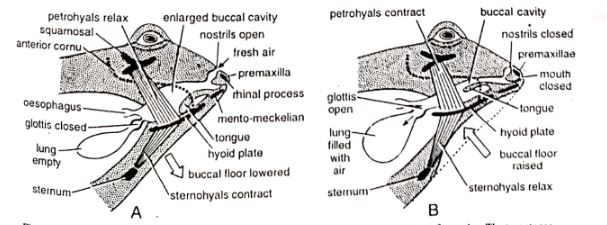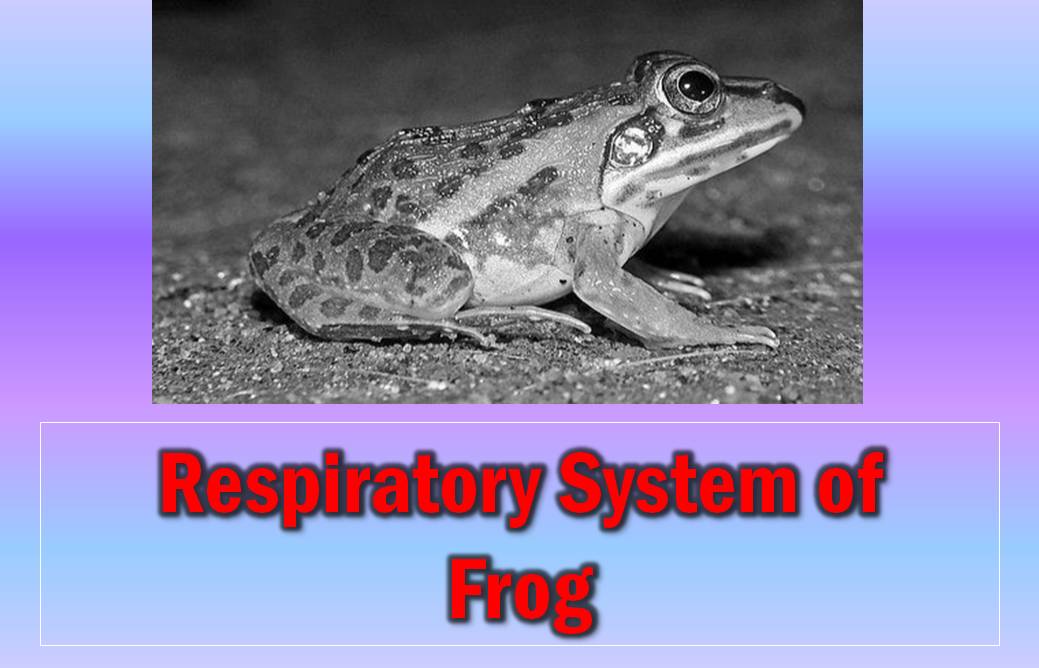In this article, we will learn about the respiratory system of frog.
What is the Respiratory System?
The respiratory system is a physiological system by which an animal intakes oxygen and releases carbon dioxide to produce energy in order to keep the body functioning.
Respiratory System of Frog
In larval stage, frogs perform their respiration through external gills but after developed into adult, they perform their respiration through lungs. In adult stage, frogs can perform their respiration in three different ways. They are –
- Cutaneous Respiration
- Buccal Respiration &
- Pulmonary Respiration (through lungs).
Cutaneous Respiration
- Cutaneous respiration is done with the help of skin.
- This type of respiration runs all day long whether the frog is in or out of the water.
- This is the only mode of respiration during hibernation.
- The skin of frog is rich with blood and is permeable to gases.
- Before Oxygen can diffuse into the blood, it needs to dissolve in the water first.
- That’s why frogs always keep their skin moist.
- Oxygen first dissolve into the moist surface of the skin. Then the oxygen diffuses into the blood and the CO2 of the blood diffuses into the moist surface of the skin. That’s how the cutaneous respiration takes place.
Buccal Respiration
- During buccal respiration, the mouth remains permanently closed.
- The nostrils remain open.
- The frog repeatedly takes air into the buccal cavity and expells out to the outside.
- The mucous epithelial lining of the buccal cavity is rich with blood capillaries and highly permeable to gases.
- Air enters into the buccal cavity through the opened nostrils and dissolved into the water of the buccal cavity.
- Then the oxygen diffuses into the blood capillaries and the Carbon dioxide diffuses into the water. Thus the gaseous exchange takes place.
Pulmonary Respiration
Frogs have their lungs and they can respire with the help of lungs. The respiratory system of frog through lungs described below.
Respiratory Tract
- The respiratory tract consists of the external nostrils, nasal chambers, internal nostrils, bucco-pharyngeal cavity, glottis, laryngo-tracheal chamber, two bronchi, bronchioles, and lungs.
- A pair of external nostrils are present at the dorsal surface of the head.
- External nostrils lead into the nasal chambers.
- The nasal chambers lead open to the buccal cavity through the internal nostrils.
- Both the buccal cavity and pharynx are termed as bucco-pharyngeal cavity in frogs.
- The glottis is located on the floor of the pharynx and it opens into the laryngo-tracheal chamber.
- The vocal cords are present in the larynx.
- The larynx leads to the long tubular trachea.
- The trachea divides into two bronchi.
- Both bronchi further divide into bronchioles.
- Both bronchi open to the lungs.
- There are two lungs present.
- They are thin-walled and highly elastic sacs.
- The inner surface of the lungs contains many small air sacs or alveoli.
- The alveoli are richly supplied with blood capillaries where the gaseous exchange takes place.
Respiratory Mechanism

a) Inspiration
- The frog closes its mouth and glottis.
- The nostrils remain open.
- The sternohyal muscles contract which enlarges the buccal cavity.
- The air enters the buccal cavity as the volume increases.
- Now the glottis is opened, the external nostrils are closed and the petrohyal muscles contract to reduce the volume of the buccal cavity.
- The reduction in the volume of the buccal cavity forces the air through the opened glottis to the lungs.

b) Expiration
- When the lungs are filled with air, the glottis closes.
- The air remains in the lungs for some times.
- Soon the glottis opened.
- Then the air is driven out to the buccal cavity with the help of the muscles of the lungs.
- Lastly, the air is expelled out to the outside.
————- THE END ————–
Read More:
- Blood Circulatory System of Frog | Diagram
- External Morphology of Frog | Diagram
- Digestive system of Frog with Diagram
- Urinogenital System of Frog | Diagram
- Nervous System and Sense Organs of Frog | Diagram
- Hoplobatrachus tigerinus (Previously Rana tigrina) | Indian Bull Frog
- General Characters of All Classes of Vertebrates.

